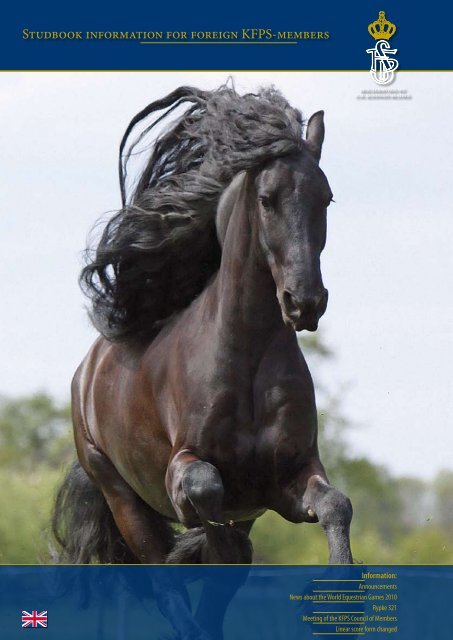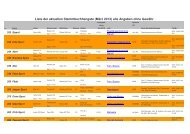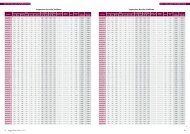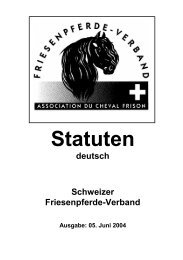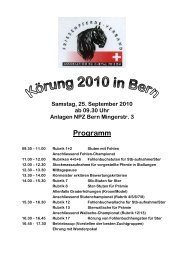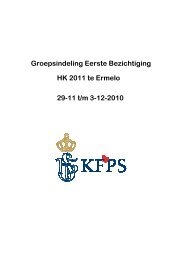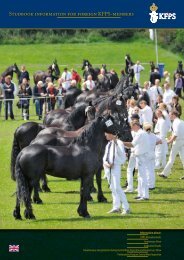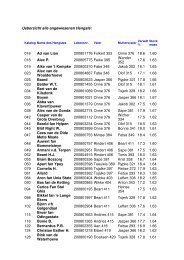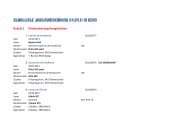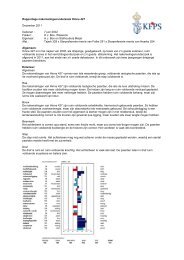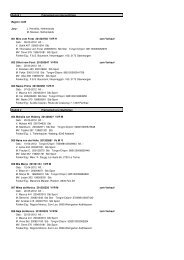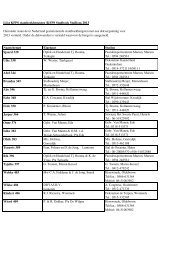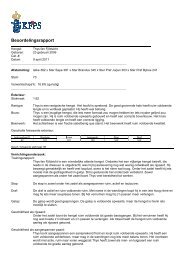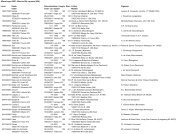Studbook information for foreign KFPS-members
Studbook information for foreign KFPS-members
Studbook information for foreign KFPS-members
Create successful ePaper yourself
Turn your PDF publications into a flip-book with our unique Google optimized e-Paper software.
<strong>Studbook</strong> <strong>in<strong>for</strong>mation</strong> <strong>for</strong> <strong>for</strong>eign <strong>KFPS</strong>-<strong>members</strong>In<strong>for</strong>mation:AnnouncementsNews about the World Equestrian Games 2010Rypke 321Meeting of the <strong>KFPS</strong> Council of MembersLinear score <strong>for</strong>m changed
<strong>KFPS</strong> AnnouncementsFees <strong>for</strong> DNA testingThe fees <strong>for</strong> DNA testing were changed on April 1, 2010. Since that date,the costs <strong>for</strong> DNA testing have been separated from the administrationcosts <strong>for</strong> requesting DNA testing. Unchanged is the fact that <strong>for</strong> everyrequest the administration costs are charged only once, no matter howmany horses are being tested. The fees are as follows:Members (including sales tax) Members (excluding sales tax)DNA testing: 1 horse € 47.60 € 40.00DNA testing: 2 horses € 95.20 € 80.00DNA testing: 3 horses € 142.80 € 120.00Administration costs <strong>for</strong> requesting DNA testing(regardless of the number of horses) € 29.75 € 25.00Rules <strong>for</strong> the identification & registrationof foalsImportant notice <strong>for</strong> breeders: The rules <strong>for</strong> I&R are strictly en<strong>for</strong>ced bythe <strong>KFPS</strong>. The basic rules, based on both the EU regulation and the <strong>KFPS</strong>registration rules, that you have to consider are:- For proper identification, your Friesian foal must be implanted witha microchip and you must have applied to the <strong>KFPS</strong> <strong>for</strong> the foal’s passportwithin 6 months of its birth. If you exceed this deadline, the <strong>KFPS</strong> is legallyobliged to note in the passport that the animal is not suitable <strong>for</strong> slaughter<strong>for</strong> human consumption.- If you also want to register the pedigree, the foal must be at theside of its dam at the time the microchip is implanted.If you cannot fulfill these conditions, registration of the pedigree can takeplace only after DNA verification, the costs of which shall be incurred bythe owner.As you can see, the phrase ‘implanting a microchip must be done withinthe same calendar year as the birth of the foal’ has been deleted.The implanting of a microchip is done at no charge by the <strong>KFPS</strong> at <strong>Studbook</strong>Inspections and local breeding association events.Announcement of the dates <strong>for</strong> the <strong>KFPS</strong>Central InspectionA decision regarding the dates <strong>for</strong> the Central Inspection has now beenmade. This event will be held on October 22 and 23 in the Fries CongresCentrum in Drachten. The final competitions <strong>for</strong> the sports events will takeplace on Friday, and as many inspections as possible will be scheduled<strong>for</strong> Saturday, although the yearlings, two-year-olds and geldings willprobably be inspected on Friday. The final version of the program will beannounced during the summer.Please note that the deadline <strong>for</strong> applying <strong>for</strong> the participation of Dutchhorses in the Central Inspection is Sunday, September 12, 2010. By thatdate, your application <strong>for</strong>m <strong>for</strong> the Central Inspection should have beenreceived by the <strong>KFPS</strong>. If you hope to earn a ticket <strong>for</strong> the Central Inspection,be sure to have your horse inspected on time. And, particularly important,don’t <strong>for</strong>get to send in an application <strong>for</strong>m <strong>for</strong> your horse! Lateentries will not be accepted.The only exceptions apply to the inspection in Denmark (only the inspectionto be held in Vilhelmsborg on September 17 through 19, 2010) and inGermany (only the inspection to be held in Negerbötel on September 19,2010). The application <strong>for</strong>ms <strong>for</strong> any Danish or German horses participatingin these inspections should be faxed or e-mailed to the <strong>KFPS</strong> no laterthan September 19, 2010.Central Inspection Reinspection: the Central Inspection is followed bya reinspection and a post-inspection. The date and location will be announcedlater. The <strong>KFPS</strong> will make application <strong>for</strong>ms <strong>for</strong> these availableafter the Central Inspection.Helping the <strong>KFPS</strong> by submitting cover dataon timeCover data have to be submitted to the <strong>KFPS</strong> within 2 weeks after the cover.Any foal born as a result of a cover that was not reported within thisperiod will have to have its pedigree verified by means of DNA testing.The stallion manager and the mare manager have to rely on each other <strong>for</strong>all the data required to register a cover. This means that the stallion managershould already supply the mare manager with a copy of the studbookpapers at the time the stallion is reserved.Explanation of foal inspection <strong>for</strong> theawarding of premiumsFoals can receive the following premiums at an inspection:1st premium: 36 or more pointsThe foals must have earned an average score of 7 <strong>for</strong> the basic gaits.2nd premium: 33 through 35.5 pointsThe foals must not have received any unsatisfactory scores in their scoringcolumn and must have received an average of 6.5 <strong>for</strong> their basic gaits.3rd premium: 29 through 32.5 pointsIf a foal receives one score of 4 or two scores of 5, it will not receive apremium! (In some cases, an exception to this can be made, an examplebeing if the quality of the legs is unsatisfactory.)The average score <strong>for</strong> the basic gaits has to be at least 5.5.This point system is used to display the distribution of the characteristicsof the horses being bred. We want to point out that movement is an importantpart of assessment. It is thus possible <strong>for</strong> a beautifully developedfoal with characteristics very typical of the breed to receive “only” a third2
premium because its movement is inadequate <strong>for</strong> receiving a 1st or 2ndpremium, or because there were comments made about its legs.Payments made to the <strong>KFPS</strong> by <strong>for</strong>eign <strong>members</strong>This announcement concerns only those <strong>members</strong> who pay their invoicesdirectly to the <strong>KFPS</strong>. This announcement does not involve <strong>members</strong> livingin countries where payment is made through the association establishedthere. Since the bank has been charging the <strong>KFPS</strong> very high fees <strong>for</strong> cashingchecks since April 2010, we have been compelled to abandon the cashingof checks. We are thus asking that you start making your payments bymeans of a bank transfer to our international bank account number.Our international bank <strong>in<strong>for</strong>mation</strong> is as follows: our Swift code is FRBKNL-2L and our IBAN number is IBAN-NL73-FRBK-0297970364Unsure as to heights at the withers?Phryso International accidentally provided contradictory <strong>in<strong>for</strong>mation</strong> about minimum heights at the withers. Here is a listing of the correct minimumheights:- Mares:o Inclusion in studbook: at least 1.54 mo Star predicate: 1.56 mo Crown: 1.58 mo Model: 1.60 m- Geldings:o Inclusion in gelding book: at least 1.56 mo A Star gelding must measure at least 1.58 m- Stallions:o Foalbook Star: a height at the withers of at least 1.58 mo The requirements <strong>for</strong> stallions participating in the Stallion Inspection are given in the regulations <strong>for</strong> the <strong>KFPS</strong> Stallion InspectionIn addition to the minimum heights at the withers, requirements <strong>for</strong> appearance and movement apply as well. These requirements vary according tothe predicate and can be found in the <strong>KFPS</strong> registration regulations. See www.kfps.nl.Friesian horses definitely going to theWorld Equestrian GamesWhat began 18 months ago as an interesting plan is now becoming areality. Friesian horses will be participating in the opening show of theWorld Equestrian Games 2010. The opening show is scheduled <strong>for</strong> September25, 2010. A unique Stallion Train will put in an appearance on thisinternational stage. The composition of the Stallion Train is very special:the permanently established leading group will be flown in from the Netherlands.This leading group is made up of Ielke 382 ridden by ChristaLaarakkers (who is also directing the show), Hans Meganck riding Rintje V,Susan Bouwman–Wind riding Marten Hendrik, and Casper van de Oostwalridden by Saskia Meinema. The <strong>members</strong> of this leading group will beper<strong>for</strong>ming dressage movements at the Grand Prix level. The six horsesin the second part of the train will be four American sports horses. Thiswill be three approved <strong>KFPS</strong> stud stallions (Fridse 423 Sport, Mintse 384Sport and Lolke 371 Sport) supplemented by Eeltsje F. (Fabe 348) ownedby Paula Marsch. The second group is completed by the Dutch stud stallionsJerke 434, ridden by Marijke Folmer, and Sabine van de Loenhorstriding Haitse 425.In addition to these horses, another two are in training as reserve horses:Arjen 417 Sport will be acting as a stand-in <strong>for</strong> the horses in the leadinggroup. The reserve horse <strong>for</strong> “group 2” is Moud Star (Leffert 306 Sport)owned by Karen Waldron.Upcoming issues of Phryso will provide extensive introductions to theseparticipants and will keep you in<strong>for</strong>med of any developments.This unique project is being made possible by various Dutch and Americansponsors and owners. Without their support, this prestigious initiativewould not be possible.To follow this special project, look at www.kfps.nl3
<strong>KFPS</strong> AnnouncementsChange in the linear scoring <strong>for</strong>mA change in the linear scoring <strong>for</strong>m will start applying as of this inspectionseason. During this inspection season, correctness of walk will be includedin the assessment of walk (listed as a characteristic in the lower bargraph). Leg con<strong>for</strong>mation will be included as a characteristic in the “evaluatingcharacteristics” starting this season and is being changed to correctnessof <strong>for</strong>elegs. The definition of this characteristic remains exactlythe same and describes the correctness of the <strong>for</strong>elegs as viewed fromthe front. A score of 30 is the most desirable score <strong>for</strong> this characteristic.Pigeon-toed horses will have a score lower than 30, and splay-footed horseswill have a score higher than 30. This characteristic will continue to beassessed at the walk.Here is the current version of the linear scoring <strong>for</strong>m:4
Meeting of the <strong>KFPS</strong> Council of Members<strong>KFPS</strong> considers hair databaseOn May 29, four matters stood out at the <strong>KFPS</strong> Council of Members Meetingin the Dutch Putten. The service fraud connected with Rypke 321,fines <strong>for</strong> exceeding the service limitations, the Friesian Train at the WorldEquestrian Games and the costs involved in the annual Stallion Show.The Rypke matter – in several services the stallion had been replaced byanother, unregistered stallion – motivated <strong>KFPS</strong> to look into the possibilityof a database with hair taken from the mane of microchipped foals.The question is whether the costs will not be too high.As far as Rypke 321 is concerned, <strong>KFPS</strong> Chairman Cees Roozemond felt thestudbook could do little else than listen to the <strong>members</strong> and offer somemoral support.After some legal dispute, there seems to be light at the end of the tunnelin the exceeded service limitations case. After due deliberation, theCouncil of Members agreed to settling the case with the stallion ownerinvolved, Jan Folmer of the Dutch Stallion Station ‘De Nieuwe Heuvel’. Thefine is approximately 1,200,000 euros. 312,000 Euros have already beenpaid, in 2010 another 150,000 euros are to follow and the remaining450,000 euros can be paid in six instalments. The studbook had suggesteda 300,000 remission. Folmer preferred the 450,000 euros to be labelled asa contribution to the Stallion Show, but the Board decided against that.Roozemond felt there was a risk of intervening with the organisation.There<strong>for</strong>e another phrasing has been chosen.Under any other business Jan van Weperen stated there were rumours ofa conflict of interest. Roozemond responded that he himself as well as theentire Board will always be attentive to this.Fewer revenueshe <strong>KFPS</strong> Jubilee Show and the Stallion Show have resulted in fewer revenuesthan expected. The costs <strong>for</strong> the Jubilee Show were well withinbudget, said treasurer Tjalling Rollema, but the revenues were belowexpectations. The Jubilee Show was a grand success, but the attendanceon Friday was disappointing. The organisation aimed at 4,500 sold ticketsper night, but especially on Friday night this was not reached by far. Theworldwide recession was seen as the predominant cause.Roozemond regretted the absence of a Sunday afternoon show, but in retrospectit’s always easy. ‘It could have produced a full house easily.’The 2010 Stallion Show attendance was hindered by a weather alarm.Boudewijn Sengers, Financial Committee spokesman, felt a small committeehad to be <strong>for</strong>med to review the entire course of events concerningthe 2010 Stallion Show. To do so would prevent organisational blindnessand make way <strong>for</strong> improvements, he argued. The Board and the <strong>members</strong>however did not warm up to the idea.Gert Jan van der Linden suggested more could be done <strong>for</strong> and with theFriesian horse on a regional basis. ‘BCM now takes care of sponsoring, butthey don’t see the local baker, so to speak.’ <strong>KFPS</strong> is considering a SponsorCommittee.Leaving a markFor a while, Roozemond was confident money could be made with theStallion Show, he stated. ‘You can’t. But it leaves the studbook’s marknonetheless.’ All costs have been reviewed, but further cutting is not anoption. The number of days is not an issue. The venue is there and paid <strong>for</strong>.The 2009 shortage was compensated <strong>for</strong> in 2010 by, among other things,keeping ticket sales in the hands of the studbook. <strong>KFPS</strong> Director Ids Hellinga:‘We are vulnerable when it comes to the Stallion Show. There is onlyone day to really attract people, so we have added Friday night.’ On Saturdaythe attendance was short 2,500 visitors due to the weather alarm. Thestudbook usually has to add 50,000 euros – ‘and that is acceptable’ - thisyear it was in <strong>for</strong> the double amount.No Friesland supportApart from a lot of goodwill the Jubilee Show generated direct revenuesas well. When the studbook asked the Ministry of Agriculture <strong>for</strong> theirsupport in the costs <strong>for</strong> the Friesian Train going to the World EquestrianGames in September, they readily made a donation. Un<strong>for</strong>tunately, theprovince of Friesland could not be stimulated into supporting the Friesiandelegation. The costs are thought to comprise about 100,000 euros. Despitethe generosity of the Ministry of Agriculture, American sponsors andthe <strong>KFPS</strong> contribution the train is still short some 35,000 euros. Roozemondfeels confident this will not be a problem. About 60,000 people willwatch the Friesian train, not to mention viewers worldwide. What betterpromotion <strong>for</strong> the Friesian horse is there?Deposit moneyThe studbook is looking into Jaap van der Meulen’s suggestion to put anend to collecting deposit money as of January 1, 2011. There is now almost3,000,000 euros in the kitty. Van der Meulen suggested this get adistinctive status. Treasurer Rollema pointed out that without the depositmoney the financial problems in the past would have been much moresevere. But now that things are looking up, the studbook is willing to lookinto this regulation. •Text: Willem Stegenga5
BIJZONDERE ZAKENRypke 321 service fraudEarlier this year, <strong>KFPS</strong> published a press release on their website concerning Rypke 321. A routinerandom DNA test had shown that part of the foals registered as Rypke 321’s had not actually been siredby this stallion. These foals’ actual sires have since been established.Text: Marjet Bosma • Photo: Jacob MelissenIn 2009, a random DNA test showedtwo foals registered as Rypke 321offspring were not actually by thisstallion. On the basis of this test <strong>KFPS</strong>decided to test all Rypke offspringborn in 2008, 2009 and 2010. As the2008 batch showed several inconsistencies,the 2007 batch is tested aswell. If this batch proves to be (partly)registered incorrectly, further batchesare tested as well. The majority of the2008 and 2009 batches have nowbeen tested. Not one foal proved to bean actual Rypke. Two foals from the2007 batch did prove to be sired byRypke. Earlier random testing ofbatches preceding 2007 showed <strong>for</strong>tyoffspring by Rypke.Offer<strong>KFPS</strong> Executive Director Ids Hellinga:‘Rypke services naturally. His ownerRomke Annema admits to having usedstand-in stallions over the past threeyears. For the sake of our investigationwe will go as far back as necessary.’<strong>KFPS</strong> handed over the case to theDisciplinary Committee. ‘It’s important<strong>for</strong> the Disciplinary Committee toknow the scope of this case. With theongoing DNA tests we will gain a clearinsight into this.’ Hellinga spoke toAnnema alone as well as accompaniedby his laywer, Jaap van der Meulen.‘He has admitted to the mistake. Theoffer they made the victims I feel isthe correct way to deal with this.’ Theoffer consists of the differencebetween the evaluation of theassumed Rypke offspring and of atrue Rypke offspring from the samemare, plus costs, if any.Duped <strong>members</strong>Meanwhile Hellinga met with ownersof assumed Rypke offspring in hisoffice twice. ‘The first time 35 peopleattended, the second time fifteen. Itshows that the need <strong>for</strong> deliberationis decreasing somewhat. We organisedthe meetings so the duped <strong>members</strong>could tell their stories. Legallyspeaking our studbook is not a partyto the conflict and the settlementbetween the stallion owner and thevictims. However, as a studbook wenaturally regret our <strong>members</strong> beingduped in a service fraud. Our responsibilitieswith regard to the stallionowner lie in a different area. TheDisciplinary Committee will eventuallydecide on the sanctions. Oursecond reason <strong>for</strong> inviting the<strong>members</strong> involved was in<strong>for</strong>mingthem on the status of the assumedRypke offspring, such as registrationin a Bijboek. Horses in a Bijboek canalso enter inspections and acquirepredicates.’It is now known which Veulenboekstallions were used instead of Rypke.‘We’re dealing with an Aan 416 xReitse 272, Onne 376 x Rypke 321 andUlke 338 x Diedert 288. Veulenboekstallion Mintse ut ’e Mieden (by Aan416) has serviced the majority of themares.’RecommendedMister Harkema had Rypke service hisJasper mare Miranda H. Miranda is bya Ster mare. The grandmother is Stamboekand the great-grandmother isSter Preferent. She did not conceiveinstantly. Harkema: ‘Miranda was atAnnema’s <strong>for</strong> five, six weeks. WhenMiranda wasn’t pregnant after thefirst attempt, we decided to bring herin heat. Eventually, when we pickedup Miranda, she was pregnant. June2009, when Doutschen was born, Icalled Annema to tell him that a fillycould be added to Rypke’s offspring.He congratulated me and said: ‘MisterHarkema, I highly recommend Rypkethis year as well. Beware, he is gettingsomewhat older, you know…’’January 2010, Harkema received aletter from <strong>KFPS</strong> requesting he turnedin hair samples taken from Doutschenand Miranda. Harkema contactedAnnema to ask him whether or not heknew of this letter. Annema’s answerto Harkema’s question ‘Is my filly byRypke?’ was disappointing: ‘I thinkso…’. Harkema sent in the hairsamples immediately. The filly’s sireturned out to be Mintse ut ’e Mieden.Harkema: ‘Be<strong>for</strong>e any duped <strong>members</strong>could respond, Annema had alreadygot himself a lawyer. We received aletter stating we would be compensated<strong>for</strong> any loss of value by comparingthe foal’s value to that of a trueRypke offspring. All other expensesare compensated <strong>for</strong> as well. Jaap vander Meulen, licensed assessor, is toper<strong>for</strong>m the evaluations.’‘I have put everything on paper tocome to closure with the emotionalside of this case. I now look at itstrictly professionally and want to putit behind me as soon as possible. Ifshe had been a Rypke foal, she wouldstay with me until her passing. NowI’m not so sure. I have lost two yearsand I will never get them back.’Harkema is now content with the way6
BIJZONDERE ZAKENAnnema has settled matters with him.ControlRypke’s service fraud puts the <strong>KFPS</strong>control system that is to preventthese incidents from happening, onthe spot. ‘Over the last couple ofyears we have intensified our descentcontrol by per<strong>for</strong>ming more DNAtests’, says Hellinga. ‘not by morerandom tests, but by a more focussedcheck. We have been working on amore precise method in the entireprocess, from registering the serviceto registering the foal. We have sharpenedthe demands on the delivery ofservice data from the stallion owners.Overdue service <strong>in<strong>for</strong>mation</strong> increasesthe chance of mistakes andalways lead to DNA testing.’Every year some 200 DNA samples areacquired in random tests and 100 <strong>for</strong>other reasons, as Hellinga describedabove. Together with the Identification& Registration policy this shouldlead to an almost airtight controlsystem. Hellinga: ‘The system provesreliable. After DNA testing on maresand foals we detect hardly any errors.We however remain prone to errors iffraud is involved. The same goes <strong>for</strong>natural servicing. Even if wedemanded the stallion owner to handin a semen sample <strong>for</strong>m the naturallyservicing stallion, we can still not besure it’s the semen from the stallionin question. Then the PVE, theCommodity Board that supervises theregulations <strong>for</strong> certified stallionstations, would almost have to bringin a person to actually attend theservice.’PVEPVE says the semen’s test result iscompared to last years’ tests. When itestablishes significant deviations, PVEdecides on another service under itssupervision. The second option isdetermining the semen donor, thestallion, by DNA testing. PVE spokespersonPascalle de Ruyter stays thatin 2008, Annema stated he could notdeliver Rypke’s semen <strong>for</strong> the regularquality test. He had delivered Rypke’ssemen in the years prior, but Rypkerefused to jump on the phantom andrefused the artificial vagina. ‘In caseof artificial insemination the regulationsare much stricter and easier toen<strong>for</strong>ce’, says De Ruyter. ‘EU andnational regulations require the stallionowners to deliver semen <strong>for</strong>testing. In case of export the qualitydemands are even higher. When itcomes to natural servicing, the regulationsare not airtight, a situationPVE is not happy about. When anowner of a naturally servicing stallionsays he can’t deliver semen <strong>for</strong> testingbut the quality is okay, we have tobelieve him.’Stallion owners can volunteer <strong>for</strong>certification. This way, they have toanswer to PVE. If they don’t, they haveto answer to the Dutch Food andConsumer Product Safety Authority(VWA). Annema volunteered <strong>for</strong> certification.Regulation amendments‘Needless to say we really regret thiscase’, Hellinga says. ‘The question isof course how we refine and tightenthe descent control. DNA testing onall 5,000 foals born each year andtheir dams would cost us approximately400,000 Euros. Do the math:5,000 foals times 80 Euros. This takesa regulation amendment supported byour <strong>members</strong>. On the other hand, thiscase will evoke the need <strong>for</strong> moreprecise testing in our <strong>members</strong>.Another option is only testing theanimals that will produce offspring,such as all Ster mares. It’s clear thatwe need to change the regulations inthis matter. We’re not sure how yet.DNA testing a mare and a foal costs120 Euros. <strong>KFPS</strong> decided to offer DNAtests against the cost price, so theowners themselves can have thedescent checked <strong>for</strong> a reasonableprice, about 80 Euros. In the futurewe can link these tests to genomics.One hair sample then gives us <strong>in<strong>for</strong>mation</strong>on descent and <strong>for</strong> examplecongenital diseases.’7
ontwerp & druk: Banda Heerenveen bv I foto’s: Karin SevinkKoninklijke Vereniging“Het Friesch Paarden-Stamboek”Oprijlaan 1 • 9205 BZ DrachtenPostbus 624 • 9200 AP DrachtenTel. +31 (0)512 52 38 88 • Fax. +31 (0)512 53 21 46E-mail: mail@fps-studbook.comInternet: www.fps-studbook.com


